The mount is not wartime: it looks like a KMZ Jupiter-3 mount, the wartime LTM mount has a stop screw through the focus ring. This one does not, meaning the stop screw was internal. Looks like someone may have re-engraved the "m", looks polished. The red "T" was added.This is another interesting one. A legitimate wartime LTM mount (lowercase „m“) and what looks to be a legitimate pre-war lens block. The curious thing is the beautiful multi-colored coating of the lens and the far too early serial combined with a red T.

Zeiss Sonnar 1,5/5cm T Nr. 1754576 mit Leica E39 Gewinde und E-Messer Kupplung | eBay
Zeiss Sonnar 1,5/5cm T Nr. Zeiss Sonnar 1,5/5cm T No. 1754576 with Leica E39 thread and E-knife coupling, the lens has traces of use corresponding to its age, see photos, the lenses of the lens are clear, without scratches, without dust, without wiping marks, the aperture has abrasion, without oil.www.ebay.de
I have a 201x coated and T labeled Contax mount Jena 5cm 1.5 which some people believed to be much too early a serial number for a factory T designation.
The optics of this LTM version are even older. So the lens block does not match the focus mount, and the coating and T designation is very early. Maybe the lens was custom coated and engraved after the war and transplanted into a LTM mount.
Either way, a beautiful lens.
lukx
Well-known
Huh, that would make this lens one of the more elaborate „fakes“. I wonder if the lens block is Zeiss or if they just used a J3, polished and re-engraved the M and added a pre-war beauty ring with an added T to the front…The mount is not wartime: it looks like a KMZ Jupiter-3 mount, the wartime LTM mount has a stop screw through the focus ring. This one does not, meaning the stop screw was internal. Looks like someone may have re-engraved the "m", looks polished. The red "T" was added.
I can‘t speak to the coating colors. Don’t know if they look like known J3 or Zeiss or aftermarket coatings.
dexdog
Mentor
The fixture for the rear triplet has only one retaining ring with slots cut in the edge, similar to my 1962 ZOMZ J-3. The early KMZ and CZJ lens in LTM have two retaining ringsHuh, that would make this lens one of the more elaborate „fakes“. I wonder if the lens block is Zeiss or if they just used a J3, polished and re-engraved the M and added a pre-war beauty ring with an added T to the front…
I can‘t speak to the coating colors. Don’t know if they look like known J3 or Zeiss or aftermarket coatings.
Räuber
Established
I found another strange creature. 😅
https://www.fromjapan.co.jp/japan/en/auction/yahoo/input/s1124723485/
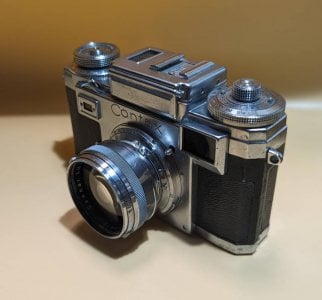
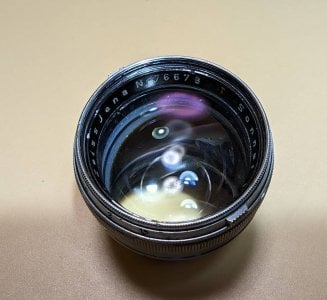
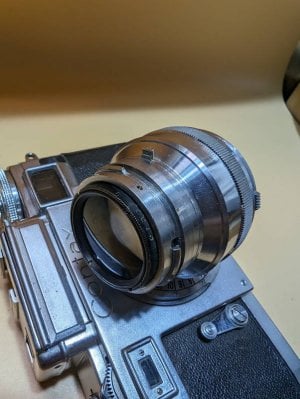
An all Chrome F11 Sonnar 5cm f/1.5 from pre-War CZJ. But with red T and serial 76673. The engraving looks kinda suspicious. But whoever made this one engraved the rear group as well. I have no idea why anyone would use such a low serial number on a Sonnar. I checked and even Oberkochen did not use this number. It is totally off!
I have no idea why anyone would use such a low serial number on a Sonnar. I checked and even Oberkochen did not use this number. It is totally off!
https://www.fromjapan.co.jp/japan/en/auction/yahoo/input/s1124723485/



An all Chrome F11 Sonnar 5cm f/1.5 from pre-War CZJ. But with red T and serial 76673. The engraving looks kinda suspicious. But whoever made this one engraved the rear group as well.
IS it missing the "2" up front? That would put it at 276xxxx.
I just checked my 1754xxx lens: the rear fixture has serrated edges, to make it easier to remove.The fixture for the rear triplet has only one retaining ring with slots cut in the edge, similar to my 1962 ZOMZ J-3. The early KMZ and CZJ lens in LTM have two retaining rings
Räuber
Established
I checked the Fabrikationsbuch again and it could fit 2 valid production batches.
- batch 36 = (20)76673 = 1937 = all Chrome F11 uncoated, matches the body and max aperture
- batch 52/53 = (26)76673 = 1940/41 = all silver F22 cheaper metal, T coated
boojum
Mentor
Just a wondering thought, is there this degree of Leitz lens counterfeiting, speculation and "Frankensteining"?
Zeiss had two issues to deal with:Just a wondering thought, is there this degree of Leitz lens counterfeiting, speculation and "Frankensteining"?
- Russians taking the equipment from USSR Occupied Germany meaning the early post-war lenses were scrounged for production;
- Russian ZK and Jupiter lenses being based closely on the Zeiss lenses, and a matter of re-engraving to pass them off.
And now we have absolute crooks selling "Carl Zeiss Jena" Jupiter-8M lenses to suckers, born every minute.

Lens SONNAR CARL ZEISS JENA 5CM F1:2 T 50MM F2, LEICA M39 LTM LENS | eBay
CARL ZEISS JENA SONNAR 5CM F1:2 T 50MM F2 LEICA M39 LTM LENS RABBIT EARS (copy ). The real focal length of this lens is 52.54mm. The lens is in good condition! Everything works fine. The glass is clean, all photos are real.
www.ebay.com
Last edited:
wlewisiii
Just another hotel clerk
Good grief, even without being a scholar of these lenses, that one is so insanely obvious.Zeiss had two issues to deal with:
- Russians taking the equipment from USSR Occupied Germany meaning the early post-war lenses were scrounged for production;
- Russian ZK and Jupiter lenses being based closely on the Zeiss lenses, and a matter of re-engraving to pass them off.
And now we have absolute crooks selling "Carl Zeiss Jena" Jupiter-8M lenses to suckers, born every minute.
Last one! 15 Suckers bought the others. The Photos are real. The lens is not.
Lens SONNAR CARL ZEISS JENA 5CM F1:2 T 50MM F2, LEICA M39 LTM LENS | eBay
CARL ZEISS JENA SONNAR 5CM F1:2 T 50MM F2 LEICA M39 LTM LENS RABBIT EARS (copy ). The real focal length of this lens is 52.54mm. The lens is in good condition! Everything works fine. The glass is clean, all photos are real.www.ebay.com
I'm so glad to have that new to me collapsible instead
boojum
Mentor
Zeiss had two issues to deal with:
- Russians taking the equipment from USSR Occupied Germany meaning the early post-war lenses were scrounged for production;
- Russian ZK and Jupiter lenses being based closely on the Zeiss lenses, and a matter of re-engraving to pass them off.
And now we have absolute crooks selling "Carl Zeiss Jena" Jupiter-8M lenses to suckers, born every minute.
Last one! 15 Suckers bought the others. The Photos are real. The lens is not.
Lens SONNAR CARL ZEISS JENA 5CM F1:2 T 50MM F2, LEICA M39 LTM LENS | eBay
CARL ZEISS JENA SONNAR 5CM F1:2 T 50MM F2 LEICA M39 LTM LENS RABBIT EARS (copy ). The real focal length of this lens is 52.54mm. The lens is in good condition! Everything works fine. The glass is clean, all photos are real.www.ebay.com
I have been extremely lucky in the Jupiters I have bought. They all seem to be legit, and good. I listened to "them what knows" and was cautious. But most of all I was lucky. I got some good Jupiters at good prices. And Sonnars and Sonnar family lenses have that special something that I like. For the price of a Leica lens I have gotten a bunch of Jupiters and some nice Canons, too. And I went large on one Sonnar and that was a lens worth what I paid for it, the Skyllaney Bertele. Being rare makes it special, yes. But what it does with an image makes it really special. I am just a Sonnar whore, I guess.
Skyllaney Bertele does color and shape well:
Räuber
Established
I think there are some other effects that elevated this effect too.Zeiss had two issues to deal with:
- Russians taking the equipment from USSR Occupied Germany meaning the early post-war lenses were scrounged for production;
- Russian ZK and Jupiter lenses being based closely on the Zeiss lenses, and a matter of re-engraving to pass them off.
And now we have absolute crooks selling "Carl Zeiss Jena" Jupiter-8M lenses to suckers, born every minute.
Last one! 15 Suckers bought the others. The Photos are real. The lens is not.
Lens SONNAR CARL ZEISS JENA 5CM F1:2 T 50MM F2, LEICA M39 LTM LENS | eBay
CARL ZEISS JENA SONNAR 5CM F1:2 T 50MM F2 LEICA M39 LTM LENS RABBIT EARS (copy ). The real focal length of this lens is 52.54mm. The lens is in good condition! Everything works fine. The glass is clean, all photos are real.www.ebay.com
- The international punishment of Carl Zeiss Jena during WWII and afterwards caused that Zeiss could not sell Contax cameras and lenses during WWII and that a lot of Zeiss owned patents got expired afterwards. Leica was not affected by this. Leica could do international business during WWII and sell their Leicas and lenses in the US. That is a reason why CZJ came up with LTM Sonnar versions to sell them over Leica in the US. The expiration of Zeiss patents made it legal for other manufacturers to copy Sonnar lenses after WWII. This was a good for Soviet and Japanese manufacturers. There was no legal fight over using the Sonnar designs or even the Contax designs. And so we had the crazy situation where 5 manufacturers churned out Sonnar 5cm lenses after WWII: CZJ, Zeiss Oberkochen, KMZ, Nikon and Canon. And even some of the cameras where simple or 1:1 copies of the Contax II. This caused that over the years mostly CZJ lenses were modified to fit a new Jupiter, Nikkor or Canon body.
- What we see with CZJ lenses manufactured during WWII and shortly after can be mostly divided into 2 groups: (Soviet) KMZ manufacturing and (German) black market manufacturing. KMZ used up all parts and lenses they transfered from Jena to Krasnogorsk and finished them to either Krasnogorsk Sonnars, Jupiters or even CZJ Sonnars. Those lenses are not that Frankenstein because they state what they are and look and behave like typical Sonnars. The German black market production not so much. There even might be a big CZJ black market operation going on of CZJ employees grinding and assembling lenses in their spare time. There were a lot of (illegal) workshops that could fit a CZJ lens to Leica bodies. Skilled craftsman / Ex-CZJ workers that could disassemble the original CZJ lens and rehouse it. Or build a lens from spare parts found in the bin or stolen in the chaotic years in the Jena factory. Some are easy to spot because the serial is fake. Others are very weird looking and others look like the perfect CZJ lens you would want to buy.
- That brings me to the Leica effect. There would not be such an amount of Franken Sonnars if there were not Leica. Although the Contax was the more advanced camera the Leica cameras had the most success. Zeiss could not outsell Leica. But Leitz does not have a Sonnar. The Xenon was an inferior lens compared to the Sonnar. And most Leica owners wanted a Sonnar 1.5 on their Leica. But Zeiss only produced LTM Sonnars in a very small amount. Not enough to satisfy the desire. Most Franken Sonnars are exactly this, a modified CZJ Sonnar that fits a LTM Leica. Since CZJ was not doing this the black market does the job. Especially US GIS were fancy to get a Sonnar to their new acquired Leica I. And the technical skilled people in Germany that endured some hard years after the war were eager to please the desire to fetch some money at the black market.
- The Leica effect still continues. From all modifications the Leica LTM modification might be the most done modification to vintage Sonnar lenses. Modifying a Contax Sonnar and put it into an LTM body is easy when you have a donator Jupiter body. Today this mod might get you some 100 to 300 bugs in doing so. Some donator lenses are cheap and rehousing is easy. Some doing this for a living (like Skyllaney) and some because Leica Sonnars are easier to work with. I know Brian has some of his Sonnars rehoused too.
- Then there are decades of time where vintage CZJ Sonnar lenses could fall of to the ground, deteriorate or been wiped to death. There might be a lot of Franken Sonnars created in the process of repairing one lens with parts from another lens.
- A major effect in my book is the missing documentation of Sonnar lens designs. A lot of people can not tell a fake lens apart from a real vintage one. One reason is missing documentation. Zeiss created a big mystery around their lenses. They are not very transparent. I don't know how Leica handles things but there are a lot of obsessed Leica people knowing every model number and when Leica produced it in which year in what country. And you can look this information up. And that is the point were Zeiss fails miserably. They tell you not to buy fake Zeiss lenses but give you no indication what you should look for. And Zeiss created some mess by their own. If you look up Zeiss lenses over the decades there is no rule that is not broken by Zeiss. They create so much different versions of each lens that it is hard to know all of them. It got better when they moved production to Japan but before it is difficult. And you get no help from Zeiss with this issue.
wlewisiii
Just another hotel clerk
I don't know, I bet Brian could make one of the collapsible Summicron's work in a Contax/Nikon mount 
That said, if I could get my paws on a really really nice Summitar, I could almost be tempted to see if I could convince him to try with one of those. I always liked it better than the 'cron.
That said, if I could get my paws on a really really nice Summitar, I could almost be tempted to see if I could convince him to try with one of those. I always liked it better than the 'cron.
TenEleven
Well-known
Since this question dropped off before it could get answered, I will. Oberkochen lenses are all complete redesigns and re-computations.Interesting bit of information I was not aware of. Is the same true for the Oberkochen Sonnar lenses? Should be since they had to start from scratch in West Germany too.
So the mystery around this lens is mostly solved. It is a post-war Sonnar as a replacement for a pre-war lens. The original lens probably does not exist anymore.
You can not interchange lenses or individual elements between the two versions. Same goes for the mechanical parts. Even the housings will not fit. The most famous and obvious being the Biogon recomputation, making it shorter to fit the IIa and IIIa.
What's more is that due to the mechanical design and layout it's basically near impossible to "Leica-ify" post-war Opton Sonnars into a 51.6mm focal length. This makes these lenses also a much less likely target for fakers and modders alike.
TenEleven
Well-known
I doubt that Leica has the Franken lens issue in such an amount like Zeiss. Put short there is no need to create a Franken Summicron, technical impossible and unneeded, and if so every Leica fan boy would notice immediately that this is no real Leica lens and defy it. 😅
Oh don't be so sure of that, I have seen plenty of Leica/Leitz fakes, maybe less online but the camera shops have tons. I think a contributing factor might be that if you sell to egregious Leica fakes online it seems likely Leitz sends you a C&D. Zeiss doesn't seem to really give much of a damn, whereas Leitz is much more protective of their brand, still.
But since you usually need a base camera or lens to work off on it's usually Elmars (Industars) or very dubious Barnack Leicas (Feds). In one or two cases someone even used a Japanese lens/body as the base, which sort of works because they copied a lot of the design cues from Leitz, even more so than the Russians.
The quality from these fakes usually ranges from "Is this a joke?" (most of them) to needing to notice very very minor details or discrepancies (the minority).
Edit: I think it just makes more sense, economically, to try and palm off very shoddy fakes than actually put in the effort. I mean, consider this: I can spend 30 minutes and make 200 bucks if I manage to catch a rube who don't know. Or I can sink in 60+ hours and make an incredibly good fake that some will still spot as fake, but now I can make 500 bucks.
Last edited:
The closest of the vintage line- Chinese Red Flag 20, over 50 years ago.
TenEleven
Well-known
I have seen 'T' coated lenses as early as 1.4 million (black and nickel generation) - I think Brian already said this, but you could send lenses back for repair/coating to Zeiss for a good while. Zeiss also coated lenses as early as ~1.9million in a faint blue coating that is easily damaged ('T' has more transmission and is harder) they did not designate the coating as 'T' until around ~2.4million or so, when they likely finalized the tech and made it secret.This is another interesting one. A legitimate wartime LTM mount (lowercase „m“) and what looks to be a legitimate pre-war lens block. The curious thing is the beautiful multi-colored coating of the lens and the far too early serial combined with a red T.

Zeiss Sonnar 1,5/5cm T Nr. 1754576 mit Leica E39 Gewinde und E-Messer Kupplung | eBay
Zeiss Sonnar 1,5/5cm T Nr. Zeiss Sonnar 1,5/5cm T No. 1754576 with Leica E39 thread and E-knife coupling, the lens has traces of use corresponding to its age, see photos, the lenses of the lens are clear, without scratches, without dust, without wiping marks, the aperture has abrasion, without oil.www.ebay.de
I have a 201x coated and T labeled Contax mount Jena 5cm 1.5 which some people believed to be much too early a serial number for a factory T designation.
The optics of this LTM version are even older. So the lens block does not match the focus mount, and the coating and T designation is very early. Maybe the lens was custom coated and engraved after the war and transplanted into a LTM mount.
Either way, a beautiful lens.
Regarding the lens posted, three other things I have noted which have not been pointed out here yet:
- the distance scale ring appears to be brass. In the third picture a small mark is visible, where perhaps the tech mistakenly tried to drill a hole. It's a shiny gold color
- the screw holding both mechanics and optics in the thread mount is a counter-sunk(!) flat-head screw. I have never seen that before. It looks professionally done
- the distance scale ring font is the correct one and at the very least from a very early Jupiter-3 - later on they exaggerated the size difference between leading digits and fractions
Very strange specimen, indeed.
Last edited:
stuart_115
Member
Just a wondering thought, is there this degree of Leitz lens counterfeiting, speculation and "Frankensteining"?
I think much of the conterfeiting has to do with copying the design people like best and having the German patents become void after WWII.I think there are some other effects that elevated this effect too.
I doubt that Leica has the Franken lens issue in such an amount like Zeiss. Put short there is no need to create a Franken Summicron, technical impossible and unneeded, and if so every Leica fan boy would notice immediately that this is no real Leica lens and defy it. 😅
- The international punishment of Carl Zeiss Jena during WWII and afterwards caused that Zeiss could not sell Contax cameras and lenses during WWII and that a lot of Zeiss owned patents got expired afterwards. Leica was not affected by this. Leica could do international business during WWII and sell their Leicas and lenses in the US. That is a reason why CZJ came up with LTM Sonnar versions to sell them over Leica in the US. The expiration of Zeiss patents made it legal for other manufacturers to copy Sonnar lenses after WWII. This was a good for Soviet and Japanese manufacturers. There was no legal fight over using the Sonnar designs or even the Contax designs. And so we had the crazy situation where 5 manufacturers churned out Sonnar 5cm lenses after WWII: CZJ, Zeiss Oberkochen, KMZ, Nikon and Canon. And even some of the cameras where simple or 1:1 copies of the Contax II. This caused that over the years mostly CZJ lenses were modified to fit a new Jupiter, Nikkor or Canon body.
- What we see with CZJ lenses manufactured during WWII and shortly after can be mostly divided into 2 groups: (Soviet) KMZ manufacturing and (German) black market manufacturing. KMZ used up all parts and lenses they transfered from Jena to Krasnogorsk and finished them to either Krasnogorsk Sonnars, Jupiters or even CZJ Sonnars. Those lenses are not that Frankenstein because they state what they are and look and behave like typical Sonnars. The German black market production not so much. There even might be a big CZJ black market operation going on of CZJ employees grinding and assembling lenses in their spare time. There were a lot of (illegal) workshops that could fit a CZJ lens to Leica bodies. Skilled craftsman / Ex-CZJ workers that could disassemble the original CZJ lens and rehouse it. Or build a lens from spare parts found in the bin or stolen in the chaotic years in the Jena factory. Some are easy to spot because the serial is fake. Others are very weird looking and others look like the perfect CZJ lens you would want to buy.
- That brings me to the Leica effect. There would not be such an amount of Franken Sonnars if there were not Leica. Although the Contax was the more advanced camera the Leica cameras had the most success. Zeiss could not outsell Leica. But Leitz does not have a Sonnar. The Xenon was an inferior lens compared to the Sonnar. And most Leica owners wanted a Sonnar 1.5 on their Leica. But Zeiss only produced LTM Sonnars in a very small amount. Not enough to satisfy the desire. Most Franken Sonnars are exactly this, a modified CZJ Sonnar that fits a LTM Leica. Since CZJ was not doing this the black market does the job. Especially US GIS were fancy to get a Sonnar to their new acquired Leica I. And the technical skilled people in Germany that endured some hard years after the war were eager to please the desire to fetch some money at the black market.
- The Leica effect still continues. From all modifications the Leica LTM modification might be the most done modification to vintage Sonnar lenses. Modifying a Contax Sonnar and put it into an LTM body is easy when you have a donator Jupiter body. Today this mod might get you some 100 to 300 bugs in doing so. Some donator lenses are cheap and rehousing is easy. Some doing this for a living (like Skyllaney) and some because Leica Sonnars are easier to work with. I know Brian has some of his Sonnars rehoused too.
- Then there are decades of time where vintage CZJ Sonnar lenses could fall of to the ground, deteriorate or been wiped to death. There might be a lot of Franken Sonnars created in the process of repairing one lens with parts from another lens.
- A major effect in my book is the missing documentation of Sonnar lens designs. A lot of people can not tell a fake lens apart from a real vintage one. One reason is missing documentation. Zeiss created a big mystery around their lenses. They are not very transparent. I don't know how Leica handles things but there are a lot of obsessed Leica people knowing every model number and when Leica produced it in which year in what country. And you can look this information up. And that is the point were Zeiss fails miserably. They tell you not to buy fake Zeiss lenses but give you no indication what you should look for. And Zeiss created some mess by their own. If you look up Zeiss lenses over the decades there is no rule that is not broken by Zeiss. They create so much different versions of each lens that it is hard to know all of them. It got better when they moved production to Japan but before it is difficult. And you get no help from Zeiss with this issue.

My guess is that Leica bodies where appreciated for their simplicity and reliability, and Contax bodies where seen as too complex or inferior. On the other hand I guess that Zeiss lenses are/where top of the line, where Leitz glass was a good second. Also Leitz could not even make a high speed Sonnar and outsourced the Xenon to Schneider.
Funny enough, while Soviet copies are considered quite inferior, the Japanese copies are considered up to the same standard.
wlewisiii
Just another hotel clerk
During the Pacific war, Japanese Navy binoculars made by Nikon were prized war souvenirs as they were superior to those made by anyone else - even supposedly to those from Zeiss.Funny enough, while Soviet copies are considered quite inferior, the Japanese copies are considered up to the same standard.
The post-war Japanese Quality Control is amazing. I have collected several lenses made in the 1940s, shortly after the war ended. All had tight quality control, all worked, all focused perfectly on my Leica M9. I also have several Jupiter-3's made during the same period. All required work. The focal length was too short on one from 1950, and it was held in the mount using sewing thread wrapped around the threads of the barrel. It could not be focused on the Contax/Kiev body, could not get the barrel close enough to the image plane. Glass was perfect. I think it was assembly practice. It has perfect Zeiss glass in it. I increased the stand-off for the rear group and converted to Leica mount. Later, bought a second 1950 J-3- no sewing thread, but shims way-off for Contax/Kiev. Converted it to LTM as well.Funny enough, while Soviet copies are considered quite inferior, the Japanese copies are considered up to the same standard.
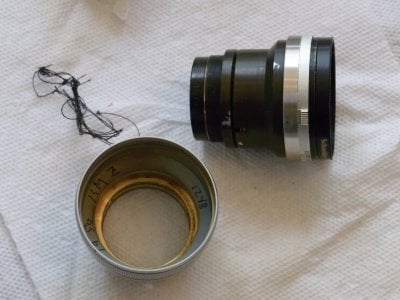
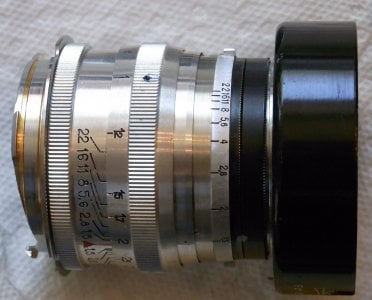
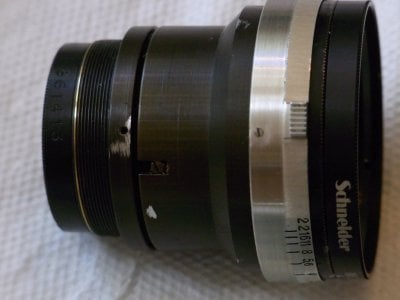

Share:
-
This site uses cookies to help personalise content, tailor your experience and to keep you logged in if you register.
By continuing to use this site, you are consenting to our use of cookies.

